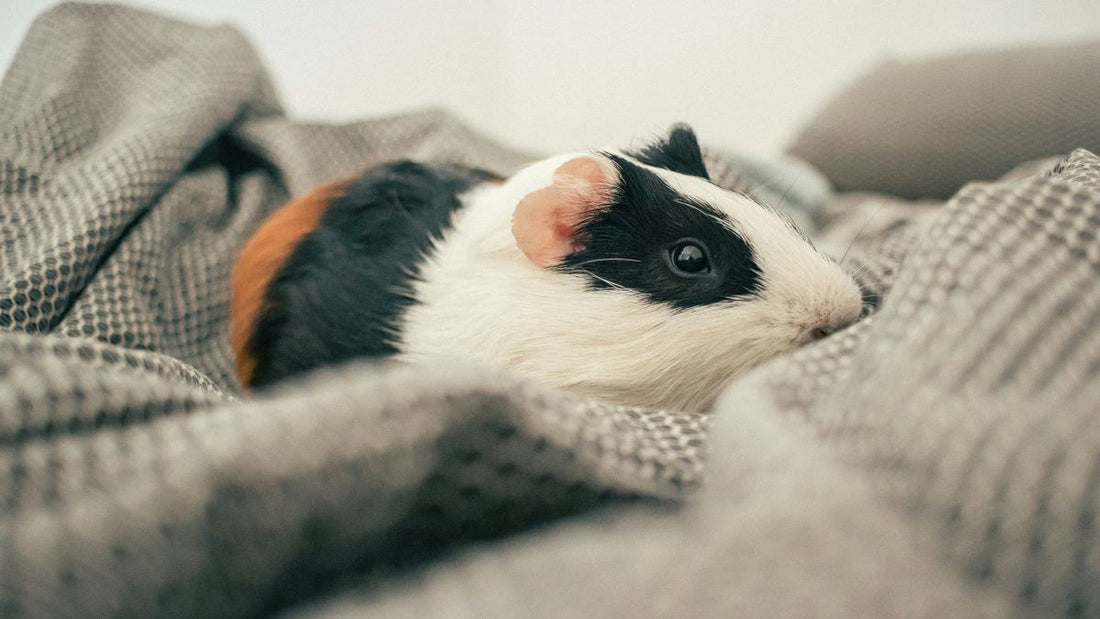Guinea pigs are sensitive little creatures, so it's important to always consider the ambient temperature they're in.
In the summer, it's important not to let them overheat. But unfortunately for us, in the UK we usually need to be more concerned with how to keep a guinea pig warm!
So here's what you need to know.
How to Keep Outdoor Guinea Pigs Warm
It's absolutely possible for your little piggies to live outside throughout the year (once they're older than about six to eight weeks and assuming they’re not hairless, skinny pigs).
If you do keep your guinea pig(s) outside and don't bring them in, it's important to make provisions during the winter months and any other cold weather spells.
What Is the Ideal Temperature for Guinea Pigs?
Their preferred temperature is between 18 - 23°, so there are a few things you can do to keep your guinea pig warm when the temperature drops.
The RSPCA does recommend bringing your cavies inside if the outside temperature drops below 15°.
Housing Outdoor Guinea Pigs
Here are some things to consider for guinea pigs outdoors all year.
Bring Your Guinea Pigs Inside
You do need to consider the mess, other pets and any type of fumes/scents as well as loud noises they might be exposed to. (Your little precious is sensitive; we told you at the beginning!) But on the coldest days, this might be a good solution.

Move the Hutch to A More Sheltered Spot Outside
If moving your pet's cage into your home isn't possible then you could find a better location in your garden.
The first thing you can do to protect your pet is move the guinea pig hutch away from any drafts. Consider putting it against the house in a sheltered part of your garden. If you have a shed the cage could go in that will really protect it from the wind and rain.
Don't put them in the garage, though. The car exhaust fumes are overwhelming.
Another thing you can do to help the piggies keep warm is to raise the hutch off the floor. If it isn't already off the ground, then this can help in two ways.
One, it stops the bottom of the hutch from being directly on the ground that might freeze. And two, heat rises, so the higher the cage is, the more it will trap any available warmth.
Insulate the Cage
This doesn't need to be an expensive job. You can use cardboard and layers of newspaper to line and insulate the inside of the cage. Just this can go a long way to making things more pleasant for your guinea pig.
If the temperatures really drop and you need something more significant, use tarpaulin, blankets or even off-cuts of carpet. It's ideal to nail these down so they don't blow off in the wind.
You can also get hutch covers that help prevent adverse weather from getting inside the cage.
Provide More Bedding
Good quality hay is an absolute essential when keeping guinea pigs.
We have just the stuff here if you need some.
Make sure you're adding plenty of extra during the cold winter. Put it on top of the newspaper to compound the insulating effect.
The benefit of hay is two-fold:
First, adding more helps insulate the cadge. By providing plenty of it, your pet can burrow in amongst it to keep warm.

Secondly, it's a good food source for them to graze on. Guinea pigs' bodies burn extra calories in the cold as it takes energy to keep them warm. So they need extra food to sustain them when it's chilly.
You could also put fleecy blankets and fabric guinea pig beds in the hutch. Make sure you quickly remove anything that gets wet though, and only use bedding with suitable fabric. Ask our advice on this if you're unsure, as some types aren't safe for guinea pigs.
Provide Another Heat Source
We're not advocates of obtaining extra pets without due consideration. However, having a pair of guinea pigs, rather than one of its lonesome, is beneficial.
As well as companionship, the body heat generated when the pigs snuggle up together goes a long way to helping them stay warm. (Note that a rabbit isn't considered a good alternative to a second guinea pig.)
Alternatively, you can give your babies a small pet heat pad to generate extra warmth. There are a few different types available. But a self- heating pad will give a similar effect to a real-life buddy.
Indoor Guinea Pigs
All of the information above is relevant if you keep your pets in an indoor cage in a cold room. Just take care to modify the extra steps you're taking.
As we mentioned at the beginning, guinea pigs need just the right temperature, and it's just as bad for them to overheat as to get too cold.

Caring for Your Guinea Pigs
So now you know how to keep your guinea pigs warm in winter, feel free to ask us any other piggy-related questions.
Zoe is our resident guinea pig Riber Pro. Growing up, she owned and rescued many piggies, including the hairless strain fondly named skinny pigs.
At Riber Pets, we have lots of goodies for guineas. The best selection is in-store, but feel free to browse our online selection too.

